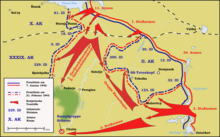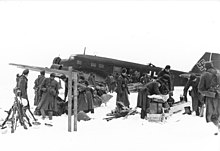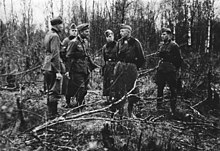Battle of Demyansk
The Kesselschlacht von Demjansk (also short Kessel von Demjansk ; Russian Демянская операция ) took place at the beginning of 1942 during the Second World War on the German-Soviet front southeast of the Ilmen lake . By February 8, the Red Army was able to encircle six German divisions around the city of Demyansk . Thanks to massive air supply, these held the boiler until German troops were able to re-establish contact with the occupation on April 21 through a relief attack . However, almost a year passed before the final evacuation of the area by the German troops. Only in March 1943 did the last German troops withdraw from there.
Boiler formation
On January 8, 1942, the troops opened the Soviet Northwestern Front (Lieutenant General Pavel Kurochkin ) between the Ilmensee and Seliger the attack on the positions of the X Army Corps (General of Artillery Christian Hansen ) and the II. Army Corps (Infantry General Walter Graf von Brockdorff-Ahlefeldt ) of the 16th Army (Colonel General Ernst Busch ) of Army Group North (Field Marshal Wilhelm Ritter von Leeb ). The Soviet 11th Army (Lieutenant General Vasili Iwanowitsch Morosow ) broke through the positions of the 290th Infantry Division on the southern bank of Lake Ilmen and was already in front of Staraya Russa on January 9th . Despite uninterrupted attacks, the city was held by German troops.
During a visit to the Fuehrer's headquarters on January 12, 1942, the Commander-in-Chief of Army Group North, Field Marshal Ritter von Leeb, requested that the positions of the German troops on the Lowat be withdrawn and counterattacks for relief at the same time. Hitler consciously accepted the encirclement, rejected the proposal and instead ordered the II Army Corps to hold Demyansk at all costs, even if the connection with the X Army Corps at Staraya Russa should be severed. Therefore, von Leeb asked for his release. Hitler granted the request and appointed Colonel-General Georg von Küchler , Commander-in-Chief of the 18th Army, to succeed von Leeb. With his decision Hitler wanted to tie up strong enemy forces and keep Demyansk as the starting point for later attack operations, which, however, were no longer to come due to a lack of strength.
From the end of January, the Soviet 1st Guards Rifle Corps (Brigadier General Afanassi Sergejewitsch Grjasnow ), following through the break-in area of the Soviet 11th Army, swung southeast from Staraya Russa into the rear of the X and II Army Corps and pushed the Soviet advancing northwest 3rd Shock Army (Lieutenant General Maxim Alexejewitsch Purkajew ), which broke through the positions of the 123rd Infantry Division west of Lake Seliger on January 9th . Despite the bitter resistance of the German troops, the heads of the Soviet troops united in the area of Salutschje after mid-February, after the last supply road and all telephone cables into the boiler had been cut on February 8th .
The Soviet 34th Army (Lieutenant General Nikolai Erastowitsch Bersarin ), standing between the Soviet 11th Army and the 3rd Shock Army, managed to break into the seam between the 290th and 30th Infantry Divisions and the area south of the station in the first days of the attack To take Beglowo. All further attacks by this army on the boiler front could be repulsed until the boiler was cleared.
The units of the Soviet 3rd Shock Army and the 34th Army lying in front of the southern front of the Kessel were combined in May 1942 as the 53rd Army (Lieutenant General Alexander Sergejewitsch Ksenofontow ).
Fight for the cauldron

Six divisions with around 95,000 soldiers and 20,000 horses were enclosed in a basin area of around 3,000 square kilometers with a front circumference of around 300 kilometers around the city of Demyansk , 75 km southeast of Lake Ilmen . This also included the SS Totenkopf Division under SS-Obergruppenführer and General of the Waffen-SS Theodor Eicke . 35 kilometers separated the containment area from the main battle line around Staraya Russa. The boiler was successfully supplied by the air, for this purpose the construction of two makeshift airfields east of Demyansk (Saoserje and Pjesti) had already started towards the end of January.
As early as February 18, 1942, the task force of the LTF (Lufttransportführer) Ost, Colonel (later Major General) Fritz Morzik received the order to deploy, for which transport air forces from several combat groups for special use (K.Gr. e.b.V.) were given their Junkers Ju 52 transport aircraft , were concentrated on take-off ports. They were later supplemented by further withdrawn capacities from Air Fleet 4 from the southern section of the Eastern Front and by newly established units. All field airports within reach were used as departure ports: Pleskau-Süd, Pleskau-West, Korowje-Selo, Ostrow-Süd, Tuleblja, Riga, Riga-Nord, Dünaburg.
By the beginning of March 1942, around 220 aircraft had been assembled for use, but only 30% of them were operational. The additional 300 transport aircraft requested by Morzik were only made available to a small extent. The maintenance and repair of the aircraft caused particular problems. In use, the aircraft were primarily at risk from anti-aircraft fire. Attacks by enemy fighters were rare due to the weakness of the Soviet air force at the time. For Morzik, this weakness was one of the most important prerequisites for the success of the supply.
In order to maintain the combat strength of the trapped troops, the army initially requested the daily supply of at least 300 tons of supplies. This amount was only reached in a few days. For the period from February 19 to May 18, 1942, 24,303 t of transported goods were reported, a daily average of 273 t. This figure is probably not entirely accurate as it was calculated by multiplying the number of aircraft used by the aircraft's load capacity. 22,093 wounded were flown out. Morzik later assessed this first boiler supply as a "negative success" due to the losses. However, the top German leadership came to the conclusion that such an air supply could also be repeated elsewhere.
The following divisions were enclosed in the boiler: (The order in which they were named corresponds to the list of the divisions from Lake Ilmen to Lake Seligersee before the start of the Soviet attack on January 8, 1942.)
-
X Army Corps
- 290th Infantry Division (Lieutenant General Theodor Freiherr von Wrede )
- 30th Infantry Division (Lieutenant General Kurt von Tippelskirch )
- SS Totenkopf Division (Obergruppenführer Theodor Eicke )
-
II Army Corps
- 12th Infantry Division (Colonel Karl Hernekamp )
- 32nd Infantry Division (Major General Wilhelm Bohnstedt )
- 123rd Infantry Division (Major General Erwin Rauch )
The General Command of the X. Army Corps (General of the Artillery Christian Hansen) withdrew from the forming pocket on Staraya Russa at the end of January and took over command of the troops defending the main battle line from Lake Ilmen via Staraya Russa to the southwest of the city. These were the following troops: 18th Infantry Division (motorized), 81st Infantry Division, Air Force Division Meindl , Reinforced Infantry Regiment 368 (later renamed Grenadier Regiment 368) ( 281st SD ), Police Regiment North, Mayer Security Regiment and several combat groups from the SS Totenkopf Division. In the first week of February the first units of the 5th Light Infantry Division arrived from France. The three enclosed divisions of the Xth Army Corps were placed under the command of the II Army Corps, which remained in the pocket, on February 18.
From the beginning of March around 6,000 men of the Soviet 1st Airborne Corps seeped from their staging area around the town of Wereteika from the north over the frozen Newij swamp between the bases Pustynia and Nory of the sparsely occupied German line of position between the 290th and 30th Infantry Divisions in the boiler area. They blocked supply routes, attacked rear supply facilities, attacked the positions of the 30th Infantry Division near Lychkovo from the inside of the boiler from March 18 to 26 (2nd airborne brigade under Lieutenant Colonel Vasilenko with the 54th ski battalion, which had since been followed) and crashed during the night from 21 to 22 March to the alleged command post of the II Army Corps in Dobrosli (the command post was relocated to Borowitschi east of Demyansk the day before as a precaution), and to the airfields around Demyansk (1st Airborne Brigade under Lieutenant Colonel Tarasov and 204th Airborne Brigade under Major Grinev). However, the attacks could be repulsed. In tough pursuit battles that lasted until the end of April, German hunting commandos succeeded in destroying or capturing the Soviet airborne troops, who had been cut off from supplies. The 1st Airborne Corps could not fulfill its combat mission, the destruction of the General Command of the II Army Corps, the destruction of the airfields and the liberation of the part of the railway line from Valdai to Staraya Russa blocked by the 30th Infantry Division between Lychkovo and Knewizy.
Relief attack
On March 20, 1942, south of Staraya Russa, the Seydlitz strike group (Lieutenant General Walther von Seydlitz-Kurzbach ) joined the so-called Brückenschlag company to open the boiler, reached the town of Ramuschewo on the Lowat River on April 20 and was able to cross the river with the storm regiment of the II. Army Corps (Lieutenant Colonel Hermann von Borries ), which had started out on April 14th from the boiler ( Operation Fallreep ). The connecting corridor, which is only four kilometers wide at its narrowest point in the area of Ramuschewo, was expanded to the north and south in the following weeks. Since the only supply route via Ramuschewo was insufficient to supply the boiler divisions, the air supply had to be maintained. It was discontinued at the end of October because the transport capacity to supply Stalingrad was required. However, after the connection corridor had been considerably expanded to the south at the end of September / beginning of October 1942 (Michael / Winkelried company), another supply line was set up in the boiler. The existing army field railway from Tuleblja to Velikoje Sselo via Cherentschizy to Losnizy was also extended into the basin.
The total losses of the flying personnel due to enemy action and crashes on emergency flights during the Demyansk boiler supply were: 2 group commanders killed, 383 officers, NCOs and men killed, missing or wounded. 262 transport aircraft were lost to enemy action, crashes and crash landings.
This successful holding and supplying of a boiler became the fateful model at the end of 1942 after the 6th Army was enclosed in Stalingrad .
The Seydlitz shock group was composed as follows:
- 5th Light Infantry Division (Major General Karl Allmendinger )
- 8th Light Infantry Division (Major General Gustav Höhne )
- 122nd Infantry Division (Major General Sigfrid Macholz )
- 329th Infantry Division (Colonel Bruno Hippler )
- Mountain Infantry Regiment 206 (Colonel Edmund Hoffmeister )
- as well as tank, assault gun and flak units
- and parts of the 18th Infantry Division (motorized) and the Air Force Field Division Meindl
consequences
After completing the combat mission, the Seydlitz strike group was disbanded on May 2, 1942 and its units were subordinated to the X Army Corps. The units remained in the connection corridor and boiler area until the evacuation in February 1943. The Mountain Infantry Regiment 206 returned to Finland in July 1942 for the 7th Mountain Division. The SS Totenkopf Division was relocated to France in October 1942 for refreshment and reclassification. The other divisions of the II Army Corps remained in the area of the former pocket until the evacuation and needed support from other units to repel the Soviet attacks.
The units were:
- SS Freikorps Danmark (Sturmbannführer Christian Frederik von Schalburg ) May to July 1942
- 81st Infantry Division (Major General Erich Schopper ) July 1942 to January 1943
- 126th Infantry Division (Lieutenant General Paul Laux ) July 1942 until eviction
- 58th Infantry Division (Lieutenant General Karl von Graffen ) December 1942 until evacuation
- 225th Infantry Division (Lieutenant General Ernst Risse ) December 1942 until evacuation
- 254th Infantry Division (General der Infanterie Friedrich Köchling ) February 1943 until evacuation
- 329th Infantry Division (Lieutenant General Johannes Mayer ) April 1942 until evacuation
After the boiler was opened - in the opinion of all management staff involved - the evacuation was the only sensible solution. Hitler refused on the grounds that the boiler area was needed as a starting point for later operations against Moscow. After the military situation on the Kessel fronts had become increasingly untenable, he finally approved the evacuation on February 1, 1943. The troops withdrew as planned from February 17 to the end of February to positions east of the Lowat River and by mid-March to the final main battle line on the Redja River. The evacuation took place during the large-scale Soviet attack ( Operation Polarstern ), which began on February 15, with the aim of finally liquidating the basin area - after several unsuccessful attempts. Most of the freed German divisions were used in the summer of 1943 in the Third Ladoga Battle .
On April 25, 1943, Adolf Hitler donated the so-called “ Demyansk Shield ” “in memory of the heroic defense of the Demyansk area against a numerically far superior enemy over several months”. The Demyansk Shield was awarded to all soldiers who were trapped in the Demyansk area from February 8 to April 21, 1942.
In addition to the numerous fallen and wounded on both sides, the Russian civilian population in particular suffered. Russian information on civilian victims in the region, etc. a. imprisoned in the camp, between 20,000 and 100,000 people. In Soviet propaganda, the numbers were revised downwards after the war in order not to diminish the troops' fame (→ censorship in the Soviet Union ). There was also considerable damage to buildings.
The German dead are now buried at the German war cemetery in Korpowo, among other places .
Individual evidence
- ↑ The small town Demyansk lies in the Oblast Novgorod southeast of Lake Ilmen , on the western edge of the Valdai Hills .
- ^ Fritz Morzik: The German transport aircraft in World War II. Bernard & Graefe Verlag für Defense, Frankfurt am Main 1966, p. 121 ff.
- ↑ Wolfgang J. Huschke: The Raisin Bomber. The Berlin Airlift 1948/49, its technical requirements and their successful implementation. 2nd Edition. Berliner Wiss.-Verl., Berlin 2008, ISBN 978-3-8305-1485-5 , pp. 19-24.
- ↑ Wolfgang J. Huschke: The Raisin Bomber. The Berlin Airlift 1948/49, its technical requirements and their successful implementation. 2nd Edition. Berliner Wiss.-Verl., Berlin 2008, ISBN 978-3-8305-1485-5 , pp. 25f.
- ↑ http://www.dradio.de/dlf/sendung/gesichtereuropas/374379/
Web links
literature
- Charles Sydnor: Soldiers of Death (Chapter 7: The Soviet Counteroffensive and the Demyansk Cauldron, pp. 175-210), Ferdinand Schöningh Verlag, 2002, ISBN 3-506-79084-6 .
- Walther von Seydlitz - Stalingrad Conflict and Consequence (Chapter: Demjansk, S. 134-143) Verlag Gerhard Stalling, 1977, ISBN 3-7979-1353-2 .
- Adolf Reinicke: The 5th Jäger Division (p. 157–262), Nebel Verlag, no year, ISBN 3-89555-103-1 .
- Klaus Pape: 329th Infantry Division: Cholm - Demjansk - Kurland , Scherzers Militaer-Verlag, ISBN 3-938845-10-4 .
- Egon Possehl: Breakthrough - 1942 - in the Demjansk Kessel , Verlag Dieter Broschat, 1994, ISBN 3-924256-54-3 .
- Eduardo Barrachina: La Batalla del Lago Ilmen , Editorial PPU Spain, 1994, ISBN 978-84-477-0315-9 .
- 8th Jäger Division Section Ia: Combat report on the campaign in Russia 1942 (March 5 to June 30 , 1942 ) , Federal Archives Freiburg, July 1, 1942.
- Fritz Morzik: The German transport pilots in World War II - The history of the "infantry of the air" , Bernard & Graefe Verlag für Wehrwesen Frankfurt am Main, 1966, no ISBN, StaBiKat signature 22A1827; P. 121 ff.
- Günter Braake: The Rhenish-Westphalian 126th Infantry Division (Chapter: Company Michael, p. 108-109, Chapter: Evacuation of the Demjansk Fortress, p. 125–126), Nebel Verlag, no year, ISBN 3-89555-197 -X .
- David Glantz: The Gosts of Demiansk. Soviet Airborne Operations Against The German Demiansk Pocket , Aberdeen Bookstore, Eastern Front I 132, 1998, without ISBN.




